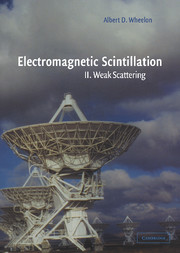Book contents
- Frontmatter
- Contents
- Preface
- 1 Introduction
- 2 The Rytov Approximation
- 3 Amplitude Variance
- 4 Spatial Covariance
- 5 The Power Spectrum and Autocorrelation
- 6 Frequency Correlations
- 7 Phase Fluctuations
- 8 Double Scattering
- 9 Field-strength Moments
- 10 Amplitude Distributions
- 11 Changes in Polarization
- 12 The Validity of the Rytov Approximation
- Appendix A Glossary of Symbols
- Appendix B Integrals of Elementary Functions
- Appendix C Integrals of Gaussian Functions
- Appendix D Bessel Functions
- Appendix E Probability Distributions
- Appendix F Delta Functions
- Appendix G Kummer Functions
- Appendix H Hypergeometric Functions
- Appendix I Aperture Averaging
- Appendix J Vector Relations
- Appendix K The Gamma Function
- Appendix L Green's Function
- Appendix M The Method of Cumulant Analysis
- Appendix N Diffraction Integrals
- Appendix O Feynman Formulas
- Author Index
- Subject Index
6 - Frequency Correlations
Published online by Cambridge University Press: 15 December 2009
- Frontmatter
- Contents
- Preface
- 1 Introduction
- 2 The Rytov Approximation
- 3 Amplitude Variance
- 4 Spatial Covariance
- 5 The Power Spectrum and Autocorrelation
- 6 Frequency Correlations
- 7 Phase Fluctuations
- 8 Double Scattering
- 9 Field-strength Moments
- 10 Amplitude Distributions
- 11 Changes in Polarization
- 12 The Validity of the Rytov Approximation
- Appendix A Glossary of Symbols
- Appendix B Integrals of Elementary Functions
- Appendix C Integrals of Gaussian Functions
- Appendix D Bessel Functions
- Appendix E Probability Distributions
- Appendix F Delta Functions
- Appendix G Kummer Functions
- Appendix H Hypergeometric Functions
- Appendix I Aperture Averaging
- Appendix J Vector Relations
- Appendix K The Gamma Function
- Appendix L Green's Function
- Appendix M The Method of Cumulant Analysis
- Appendix N Diffraction Integrals
- Appendix O Feynman Formulas
- Author Index
- Subject Index
Summary
The wavelength scaling of amplitude variance discussed in Section 3.2.4 was found to give good agreement between theory and experiment. We can take this comparison one step further and compare the detailed variations of amplitude at two wavelengths. The amplitude histories for radio-astronomical signals at 81.5 and 118.5 MHz received from a radio source in Cassiopeia [1] are reproduced in Figure 6.1. Investigations of this correlated signal behavior were originally driven by practical considerations. Radio astronomers working with very faint signals wanted to know how wide a frequency band they could use to improve the signal-to-noise ratio. Engineers designing terrestrial and satellite communication relay links wondered whether turbulence scattering would limit the information bandwidth that could be transmitted through the atmosphere.
Both questions are related to the medium bandwidth which measures the frequency separation over which received signals behave in the same way. Severe medium-bandwidth limitations had been observed on tropospheric and ionospheric scatter-propagation circuits. That experience raised the possibility that only a narrow slice of frequency spectrum would be coherent and thus useful for line-of-sight transmissions. Experimental data showed instead that a very large bandwidth should be available [2][3][4][5][6][7]. For weak scattering the signal strength is correlated over a wide range of frequencies because the strong coherent field provides a powerful stabilizing reference – as it cannot for scatter propagation.
- Type
- Chapter
- Information
- Electromagnetic Scintillation , pp. 188 - 213Publisher: Cambridge University PressPrint publication year: 2003



